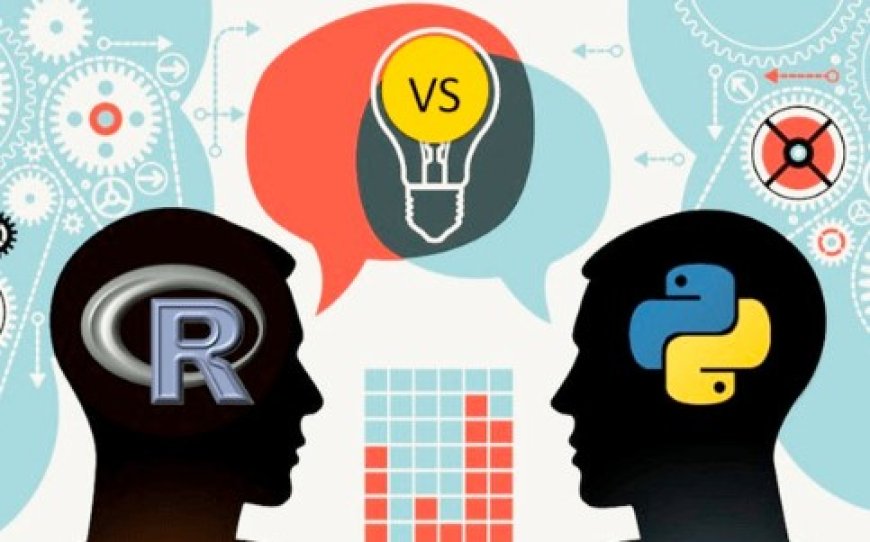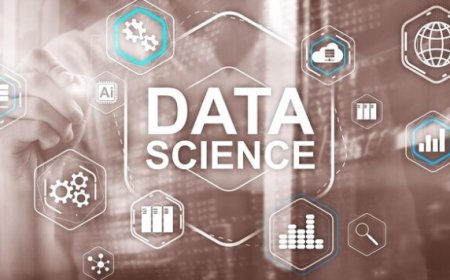R vs Python for Data Science: A Friendly Comparison
Explore the differences between R and Python for data science in this friendly comparison. Discover which language suits your data analysis needs best.

In the dynamic realm of data science, two programming languages, R and Python, have risen to prominence as the go-to choices for data analysis, visualization, and modeling. Both languages offer unique strengths and come equipped with extensive libraries and tools tailored for various data science tasks. we'll provide a comprehensive and friendly comparison between R and Python to assist you in selecting the best-fit language for your data science endeavors.
Ease of Learning and Use:
Python stands out for its simplicity and readability. Its user-friendly syntax makes it an excellent starting point for beginners and individuals transitioning from other programming languages. Python's intuitive structure promotes a gentle learning curve, making it accessible to a wide range of users.
R, on the other hand, while powerful for statistical analysis, can have a steeper learning curve, especially for those new to programming. However, it offers specialized functions and packages tailored explicitly for statistical operations, which can be highly advantageous for statisticians and data analysts.
Data Manipulation and Analysis:
Python's primary data manipulation library, pandas, is celebrated for its versatile data structures and user-friendly functions. It excels in tasks such as data cleaning, wrangling, and analysis. Moreover, pandas seamlessly integrates with other Python libraries, making it a robust choice for handling large datasets and complex data transformations.
R boasts a strong emphasis on data analysis, with built-in functionalities for managing data frames and vectors. Its dplyr package is particularly popular for data manipulation, positioning R as a preferred choice for statistical data analysis tasks.
Visualization Capabilities:
Python offers a rich spectrum of visualization libraries, including Matplotlib, Seaborn, and Plotly. These libraries provide extensive customization options, empowering data scientists to create visually stunning and informative graphs and plots.
R's ggplot2 is renowned for its expressive and elegant visualizations. Its "grammar of graphics" approach enables intricate data visualization with concise code, making it a top choice for those who prioritize sophisticated visual representation.
Statistical Capabilities:
Python provides a solid foundation for statistics, although advanced statistical operations may require additional libraries like NumPy and SciPy. Python excels in the realm of machine learning, thanks to popular libraries like scikit-learn and TensorFlow, which are widely used for tasks such as classification, regression, clustering, and deep learning.
R was purpose-built with statistical analysis in mind, offering an extensive array of built-in statistical functions and packages. R users often appreciate its comprehensive statistical capabilities, making it the preferred choice for tasks like hypothesis testing and regression analysis.
Machine Learning Libraries:
Python's scikit-learn library is a powerhouse for machine learning tasks, offering a diverse collection of algorithms and tools. Additionally, Python boasts TensorFlow and PyTorch for deep learning applications, solidifying its position as a leader in machine learning.
While R does offer machine learning libraries like caret and randomForest, its breadth and depth in this domain may not match Python's extensive ecosystem. Nevertheless, R users frequently leverage its statistical models for predictive analytics.
Community and Support:
Python boasts a massive and vibrant community, resulting in a wealth of resources and comprehensive documentation. This large user base ensures prompt and valuable responses to queries, making platforms like Stack Overflow invaluable for problem-solving.
R also enjoys an active community of statisticians and data analysts. It is well-supported by packages developed by academics and researchers, cementing its status as a reliable choice for statistical analysis.
Data Science Community and Ecosystem:
A crucial consideration when choosing between R and Python is the size and vibrancy of their respective data science ecosystems.
Python's ecosystem is renowned for its extensive libraries, including NumPy and SciPy for numerical computing, pandas for data manipulation, and scikit-learn for machine learning. TensorFlow and PyTorch have solidified Python's position in the realm of deep learning. This comprehensive toolkit has contributed significantly to Python's popularity in data science and AI development.
Conversely, R's ecosystem revolves around potent statistical packages like ggplot2, dplyr, and tidyr, designed explicitly for data analysis and visualization. It offers a specialized set of tools tailored for researchers and statisticians who prioritize robust statistical techniques.
Integration and Versatility:
Python shines in its versatility and ease of integration with other technologies and tools. Data scientists can seamlessly work with web frameworks (e.g., Django, Flask), databases (e.g., SQL, NoSQL), and other programming languages. This adaptability is invaluable for integrating data science solutions into larger software projects or building web applications with data analysis capabilities.
Industry Adoption and Job Market:
Both R and Python have found significant adoption across industries, but Python's versatility and machine learning capabilities have driven its widespread acceptance in various sectors. Companies seeking data science solutions, AI applications, and automation often favor Python for its scalability and versatility.
From a job market perspective, Python has witnessed a surge in demand for data scientists and AI specialists. Its extensive use in finance, healthcare, technology, and e-commerce translates into abundant job opportunities for data professionals skilled in Python.
Scalability and Deployment:
Python holds an advantage when it comes to scalability and deployment. Its compatibility with web frameworks, cloud services, and containerization tools like Docker makes it easier to deploy data science solutions into production environments. This versatility is particularly valuable for data engineers and data scientists who need to transition from analysis to deployment seamlessly.
R, while less flexible in this regard, still offers options for deploying models and analyses. Packages like Shiny enable interactive web applications based on R, which can be useful for creating data-driven dashboards or sharing analyses with non-technical stakeholders.
Learning Resources:
Python enjoys a wealth of learning resources, including online courses, tutorials, and books, catering to individuals at all skill levels. The extensive availability of educational content simplifies the learning journey for newcomers and facilitates ongoing skill development for experienced practitioners.
R also offers a substantial collection of learning resources, with dedicated courses and documentation tailored to data analysis and statistics. It provides a strong foundation for aspiring statisticians and data scientists.
Community and Collaboration:
Python's vast and diverse community fosters collaboration and innovation. Open-source projects and libraries receive frequent updates and contributions, ensuring that Python remains at the forefront of data science tools and techniques.
R's community is similarly passionate about advancing statistical analysis and data visualization. Collaboration within the R community often leads to the development of specialized packages that cater to unique analytical needs.
Data Science Specializations:
Consider your specific data science specialization when choosing between R and Python:
-
For general-purpose data science, machine learning, and AI applications, Python's versatility makes it a compelling choice.
-
If your focus is primarily on traditional statistical analysis, hypothesis testing, and specialized graphical techniques, R offers a rich environment for these tasks.
-
In academia and research, R remains a staple for statistical research and data analysis, while Python is increasingly gaining ground, especially in machine learning research.
-
In industry, Python's widespread adoption and comprehensive ecosystem give it a competitive edge, especially in sectors requiring scalable data solutions and AI integration.
The decision between R and Python for data science depends on your background, preferences, and project requirements. Python's ease of learning, versatility, and dominance in machine learning make it a popular choice for general-purpose data science tasks. On the other hand, R's rich statistical capabilities and visualization strengths make it a strong contender for researchers and data analysts. In the end, the choice between R and Python often comes down to personal preference and the specific demands of your data science projects. Whichever language you choose, both R and Python will empower you to uncover insights, build predictive models, and unlock the potential of your data. Happy coding and data crunching!











































